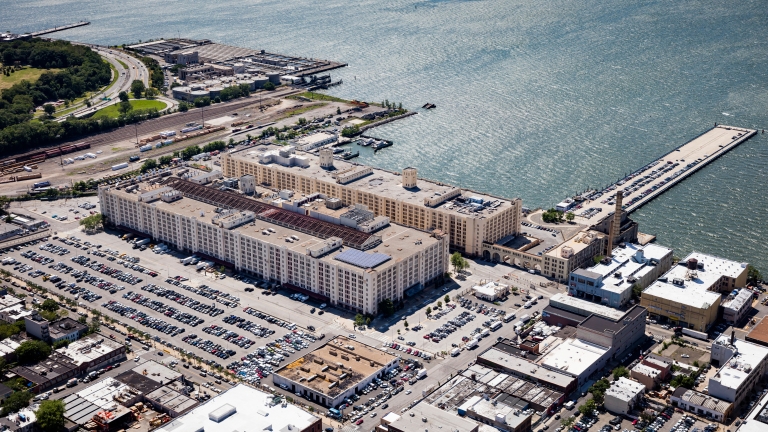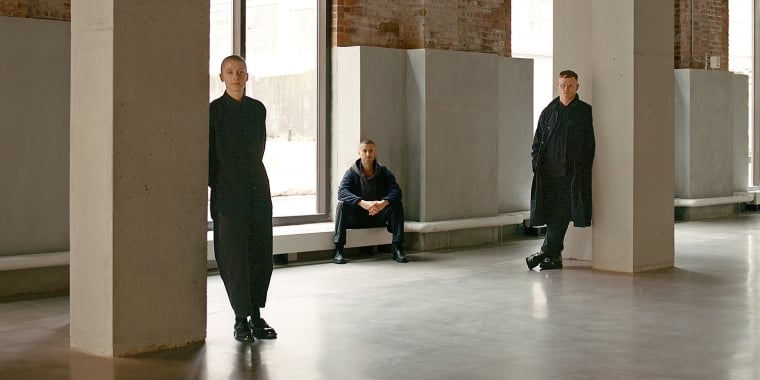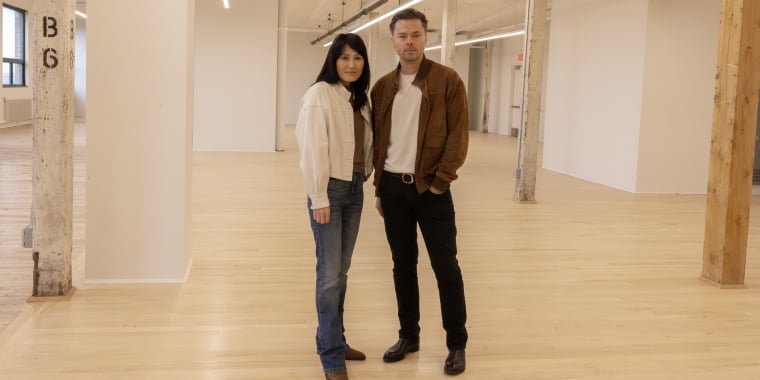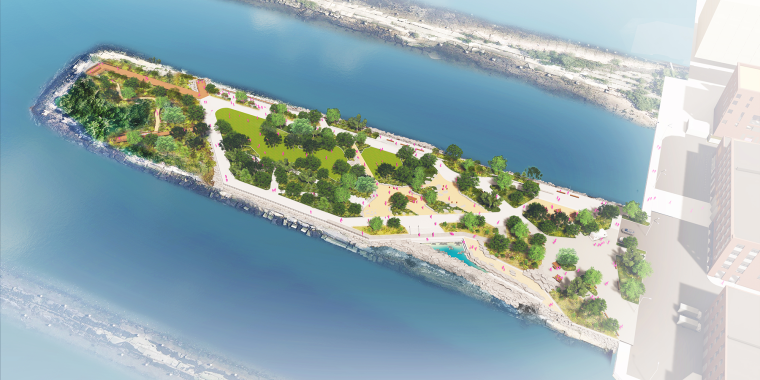NYCEDC Unveils Five Climate Tech Companies Selected to Participate in Pilots at BAT Program, Scaling Innovative Technologies on South Brooklyn Waterfront

Five Cutting-Edge Climate Tech Companies Selected to Participate in Climate Innovation Program to Test New Technologies and Unlock Solutions for Global Climate Challenges
Since Launching, Pilots at BAT Has Served 12 Companies, With Plans to Increase Pilot Support Services Through the Future BATWorks
Pilots at BAT Bolsters Mayor Adams Efforts to Create a “Harbor of the Future’ in New York City, Fulfills Key Commitments in “Green Economy Action Plan” Including Creation of Cutting-Edge Climate Innovation Hub “BATWorks”
BROOKLYN, NY—New York City Economic Development Corporation (NYCEDC) today welcomed five new companies to Pilots at BAT, a program where emerging climate technology companies can test their products in a live built environment and ultimately grow their business and impact throughout the five boroughs to confront the climate crisis. Piloting technology ranges from biobased building materials to EV charging station retrofits.
The Brooklyn Army Terminal (BAT) anchors a growing innovation ecosystem along the New York harbor with the Pilots at BAT program, and the world-class BATWorks hub that will provide start-ups with space for product research and development, as well as offer workforce training and job placement programming to New Yorkers. Last May, NYCEDC announced that a consortium led by Los Angeles Cleantech Incubator (LACI) and the Cambridge Innovation Center (CIC) will design and operate BATWorks. Starting in 2026, LACI will lead the “Pilots at BAT” program, strengthening the relationship between the nation’s two largest cities on climate innovation, by providing LACI-incubated startups with exclusive funded piloting opportunities at BAT and create a semi-permanent innovation test bed for the City Climate Innovation Challenge in New York City.
“NYCEDC is continuing to leverage assets like the historic Brooklyn Army Terminal and MADE Bush Terminal, for companies to test and scale new cutting-edge technology that will unlock solutions for the climate crisis and create fresh economic opportunity for the city,” said NYCEDC President & CEO Andrew Kimball. “We are proud that New York City’s climate future is being built here in Sunset Park with another Pilots at BAT cohort, and the creation of BATWorks, a world-class climate innovation hub, that will further drive innovation and act as a cornerstone of New York City’s Harbor of the Future.”
“As cities like New York work to decarbonize construction, it’s crucial that low-carbon materials like our hemp-based wall studs can be used easily in real-world projects” said BioTwin CEO Kit Chong, CEO of BioTwin. “It’s a privilege to pilot at BAT and this opportunity not only helps us prove our technology but also opens the door to commercial partnerships that can support a more sustainable built environment across the city and state.”
“CLIP is an innovative, patented device that transforms any standard bicycle into an electric bike in just five seconds, with zero tools required,” said CLIP CEO Som Ray. “Designed to accelerate access to clean mobility, CLIP’s plug-and-play upgrade is being deployed through community-powered, scalable CLIP Libraries, enabling shared access and local empowerment.”
“I’m a strong believer in our city’s capacity to turn bold ideas into lasting impact, and the Pilots at BAT program is proof of that commitment” said Majority Leader Amanda Farías, Chair of the Committee on Economic Development. “By leveraging our industrial waterfront as a platform for cutting-edge climate technology, we are transforming this global challenge into opportunity. This program demonstrates how comprehensive climate action and economic development go hand in hand—delivering resilience, creating sustainable industries for the future, and ensuring our city remains a global leader in green innovation.”
“Our grass-based panels outperform traditional wood-based OSB across multiple metrics. They’re stronger, lighter, more moisture-resistant, and carbon negative — all while remaining cost-competitive,” said Plantd Co-founder and CEO Nathan Silvernail. “While conventional OSB requires cutting down trees that take 10 to 12 years to grow, our perennial regrows annually on the same land, which allows us to capture carbon much faster and more efficiently than forestry operations.”
“Cast Carbon is thrilled to collaborate with BAT in showcasing to the public that we can build a new 21st century using materials that reflect our values in addition to beauty and performance,” said Cast Carbon Founder Emily Majewski. “Together we craft a future that treasures both human and nature’s health, not just theoretically but materially.”
Participating pilots receive access to spaces and infrastructure at NYCEDC’s flagship waterfront asset BAT—a vital 60-acre industrial campus—and the MADE Bush Terminal Campus to test their technologies, develop their products, show viability for customers and investors, and tap into New York City’s economy, the ninth largest in the world. Piloting technologies include:
- BioTwin has developed a low-carbon, acoustically enhanced hemp-based wall stud designed to replace steel in non-loadbearing partitions. Its flagship product, the BioStud, cuts embodied carbon by 70% and has been tested for structural, acoustic, and fire resistance performance to support commercial use.
- ClipBike reimagines the e-bike as a portable upgrade, not a new purchase. Their sleek device clips onto any standard bicycle, instantly transforming it into an electric ride with no tools, no installation. With two models, CLIP offers ranges from 6 to 15 miles and charges in under an hour from a regular wall outlet.
- Cast Carbon offers biochar-enriched wall tiles that blend clays, minerals and agricultural waste into a compostable finish. The wall tiles are designed for modular installation and disassembly, storing carbon while elevating interior aesthetics.
- Plantd is developing carbon-negative building materials manufactured from fast growing perennial grass, sequestering atmospheric carbon while outperforming traditional building materials. These panels are fire-tested, structurally robust, and designed for wall, roof, subfloor, and furniture applications.
- Voltpost is empowering communities with affordable, convenient EV charging infrastructure. Their modular Level 2 EV chargers retrofit onto existing lampposts, taking a fraction of time to install compared to EV charging projects with costly trenching and civil construction.
Installation has begun and will continue over the next few weeks. Piloting activities are expected to run for six to 12 months during which companies collect data that is critical to achieving their next commercialization milestone.
“Voltpost is proud to be part of the Pilots at BAT program to demonstrate how our lamppost charging platform is expanding affordable and convenient EV charging access in New York,” said Jeffrey Prosserman, CEO of Voltpost. “By leveraging lampposts to deploy next-generation renewable transportation infrastructure, we’re helping accelerate the transition to electric mobility while reducing costs, construction, and permitting barriers. We’re grateful to NYCEDC for creating this platform to pilot innovative technologies that will shape the city’s sustainable future.”
NYCEDC launched the Pilots at BAT program in September 2023 to activate a key real estate asset and provide the opportunity for companies to test their innovative technologies on the path to commercializing their product or services and scaling throughout New York City. As a result of the success in Pilots at BAT, last August the program expanded its reach to NYCEDC’s MADE Bush Terminal campus, providing more space and alternative environments.
NYCEDC has partnered with TRC Engineers to validate the performance data and findings of the completed Pilots at BAT demonstrations—ranging from micromobility charging to microclimate forecasting to smart boiler controls. The pilot case studies aim to showcase real-world performance, validate environmental impacts and document lessons learned to accelerate the adoption of these key technologies.
“Our team worked with the piloting companies to peer review pilot data and provide success criteria for each solution,” said TRC Vice President of Research & Technology Commercialization Pande Abhijeet “The case studies highlight the technical specifications, results and success criteria for each pilot, demonstrating the impact of the Pilots at BAT program. These case studies serve as proof of concept for the real estate sector and city governments, showcasing real-world performance and validating the environmental impact of these key technologies.”
Participating companies have translated their pilots into different follow-on opportunities including prototype development, unlocking local and state incentives, securing new funding, and generating new revenue streams through corporate partnerships. Applications are accepted on a rolling basis from companies that are developing hardware climate technologies within NYCEDC’s priority green economy sectors, resiliency, mobility and buildings. Click here for more information on piloting opportunities.
Sunset Park in South Brooklyn is an emerging hub for climate innovation. The waterfront district has extensive industrial infrastructure, a diverse array of tenants and uses, and connection to major transportation networks. NYCEDC’s primary assets in Sunset Park include BAT, the South Brooklyn Marine Terminal, and MADE Bush Terminal. Each of these assets provides unique opportunities for innovation and business development, and they support a just transition to decarbonize New York City’s economy.
This announcement builds on the Harbor Climate Collaborative—a joint initiative between NYCEDC, the Trust for Governors Island, and the Brooklyn Navy Yard Development Corporation—to link together tech piloting, tenanting, and programming opportunities across all three organizations and promote climate innovation. By unlocking 6 million square feet of space, the Collaborative will support the creation of 5,000 permanent jobs, educate and train 2,100 students, and generate $55 billion in economic impact. Additionally, the Adams administration and NYCEDC are also transforming the nearby city-owned South Brooklyn Marine Terminal into one of the largest offshore wind port facilities in the nation, which broke ground in 2024.
NYCEDC’s work across Sunset Park builds on the Adams administration’s broader strategy to develop the Harbor of the Future—a reimagined network of innovation and growth across New York City’s waterways. The Harbor of the Future includes emerging innovation centers at the Hunts Point Produce Market in the Bronx, the country’s largest offshore wind port at the South Brooklyn Marine Terminal, a new cutting-edge climate innovation hub at the Brooklyn Army Terminal in Sunset Park, modern maritime port and vibrant mixed-use community hub at the Brooklyn Marine Terminal in Red Hook, the Science Park and Research Campus in Kips Bay in Manhattan, new sustainable housing and public space on the North Shore of Staten Island, and an anchor research and educational partner with the New York Climate Exchange on Governors Island.
About NYCEDC
New York City Economic Development Corporation is a mission-driven, nonprofit organization that works for a vibrant, inclusive, and globally competitive economy for all New Yorkers. We take a comprehensive approach, through four main strategies: strengthen confidence in NYC as a great place to do business; grow innovative sectors with a focus on equity; build neighborhoods as places to live, learn, work, and play; and deliver sustainable infrastructure for communities and the city's future economy. To learn more about what we do, visit us on Facebook, X, LinkedIn, and Instagram.


